福岛核事故的调查报告(DOC 59页)
- 格式:doc
- 大小:5.96 MB
- 文档页数:59
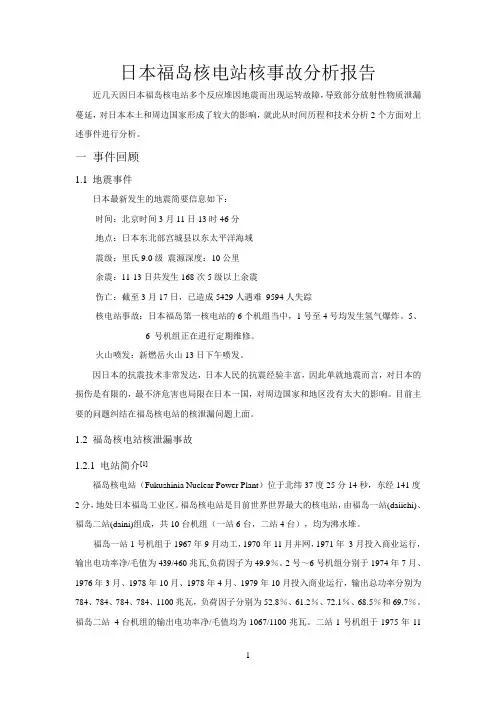
日本福岛核电站核事故分析报告近几天因日本福岛核电站多个反应堆因地震而出现运转故障,导致部分放射性物质泄漏蔓延,对日本本土和周边国家形成了较大的影响,就此从时间历程和技术分析2个方面对上述事件进行分析。
一事件回顾1.1 地震事件日本最新发生的地震简要信息如下:·时间:北京时间3月11日13时46分·地点:日本东北部宫城县以东太平洋海域·震级:里氏9.0级震源深度:10公里·余震:11-13日共发生168次5级以上余震·伤亡:截至3月17日,已造成5429人遇难9594人失踪·核电站事故:日本福岛第一核电站的6个机组当中,1号至4号均发生氢气爆炸。
5、6 号机组正在进行定期维修。
·火山喷发:新燃岳火山13日下午喷发。
因日本的抗震技术非常发达,日本人民的抗震经验丰富,因此单就地震而言,对日本的损伤是有限的,最不济危害也局限在日本一国,对周边国家和地区没有太大的影响。
目前主要的问题纠结在福岛核电站的核泄漏问题上面。
1.2 福岛核电站核泄漏事故1.2.1 电站简介[1]福岛核电站(Fukushinia Nuclear Power Plant)位于北纬37度25分14秒,东经141度2分,地处日本福岛工业区。
福岛核电站是目前世界世界最大的核电站,由福岛一站(daiichi)、福岛二站(daini)组成,共10台机组(一站6台,二站4台),均为沸水堆。
福岛一站1号机组于1967年9月动工,1970年11月并网,1971年3月投入商业运行,输出电功率净/毛值为439/460兆瓦,负荷因子为49.9%。
2号~6号机组分别于1974年7月、1976年3月、1978年10月、1978年4月、1979年10月投入商业运行,输出总功率分别为784、784、784、784、1100兆瓦,负荷因子分别为52.8%、61.2%、72.1%、68.5%和69.7%。
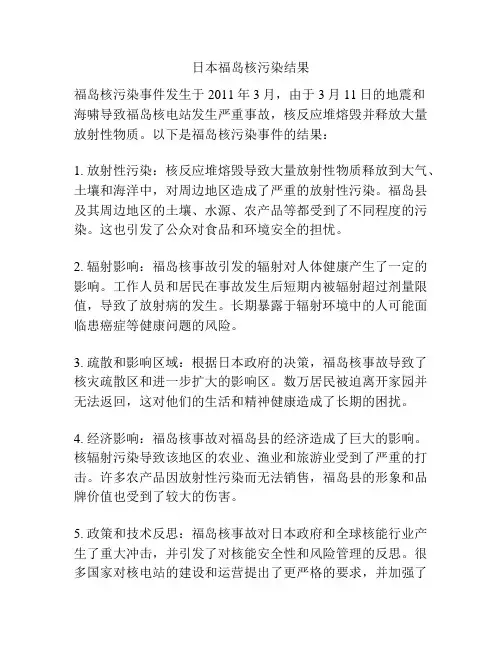
日本福岛核污染结果
福岛核污染事件发生于2011年3月,由于3月11日的地震和
海啸导致福岛核电站发生严重事故,核反应堆熔毁并释放大量放射性物质。
以下是福岛核污染事件的结果:
1. 放射性污染:核反应堆熔毁导致大量放射性物质释放到大气、土壤和海洋中,对周边地区造成了严重的放射性污染。
福岛县及其周边地区的土壤、水源、农产品等都受到了不同程度的污染。
这也引发了公众对食品和环境安全的担忧。
2. 辐射影响:福岛核事故引发的辐射对人体健康产生了一定的影响。
工作人员和居民在事故发生后短期内被辐射超过剂量限值,导致了放射病的发生。
长期暴露于辐射环境中的人可能面临患癌症等健康问题的风险。
3. 疏散和影响区域:根据日本政府的决策,福岛核事故导致了核灾疏散区和进一步扩大的影响区。
数万居民被迫离开家园并无法返回,这对他们的生活和精神健康造成了长期的困扰。
4. 经济影响:福岛核事故对福岛县的经济造成了巨大的影响。
核辐射污染导致该地区的农业、渔业和旅游业受到了严重的打击。
许多农产品因放射性污染而无法销售,福岛县的形象和品牌价值也受到了较大的伤害。
5. 政策和技术反思:福岛核事故对日本政府和全球核能行业产生了重大冲击,并引发了对核能安全性和风险管理的反思。
很多国家对核电站的建设和运营提出了更严格的要求,并加强了
核能安全监管。
此外,福岛核事故也促使人们对可再生能源和能源多样化的需求增加,以减少对核能的依赖。
总的来说,福岛核污染事件造成了巨大的环境、经济和社会影响,对福岛县和整个日本社会产生了深远的影响,也为全球核能行业带来了挑战和反思。

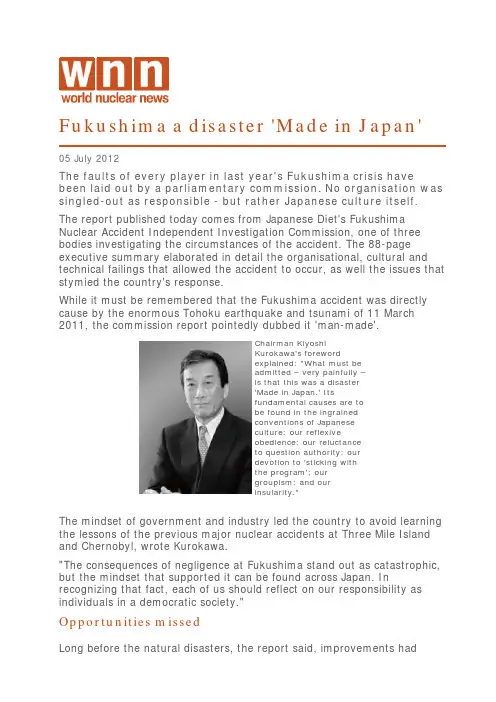
Fukushima a disaster 'Made in Japan'05 July 2012The faults of every player in last year's Fukushima crisis have been laid out by a parliamentary commission. No organisation was singled-out as responsible - but rather Japanese culture itself.The report published today comes from Japanese Diet's Fukushima Nuclear Accident Independent Investigation Commission, one of three bodies investigating the circumstances of the accident. The 88-page executive summary elaborated in detail the organisational, cultural and technical failings that allowed the accident to occur, as well the issues that stymied the country's response.While it must be remembered that the Fukushima accident was directly cause by the enormous Tohoku earthquake and tsunami of 11 March 2011, the commission report pointedly dubbed it 'man-made'.Chairman KiyoshiKurokawa's forewordexplained: "What must beadmitted – very painfully –is that this was a disaster'Made in Japan.' Itsfundamental causes are tobe found in the ingrainedconventions of Japaneseculture: our reflexiveobedience; our reluctanceto question authority; ourdevotion to 'sticking withthe program'; ourgroupism; and ourinsularity."The mindset of government and industry led the country to avoid learning the lessons of the previous major nuclear accidents at Three Mile Island and Chernobyl, wrote Kurokawa."The consequences of negligence at Fukushima stand out as catastrophic, but the mindset that supported it can be found across Japan. In recognizing that fact, each of us should reflect on our responsibility as individuals in a democratic society."Opportunities missedLong before the natural disasters, the report said, improvements hadbeen identified for Fukushima Daiichi that would have protected the plant or helped during an emergency. Some of these had been recommended but not required by the regulator NISA, and Tepco had not implemented them on its own volition by the time of the natural disasters.Principal among these were, of course, tsunami and flood mitigation. Tepco had been aware since 2006 that Fukushuima Daiichi could face a station blackout if inundated with water, as well as the potential loss of ultimate heat sink if a tsunami came that exceeded the Japan Society of Civil Engineers' official estimation. However, NISA gave no instruction to the company to prepare for severe flooding, and even told all nuclear operators that it was not necessary to plan for station blackout.During the initial response to the tsunami, this lack of readiness for station black-out was compounded by a lack of planning and training for severe accident mitigation. Plans and procedures for venting and manual operation of isolation condensers were incomplete and their implementation in emergency circumstances proved very difficult as a result.NISA also had a "negative attitude" to learning from its peers overseas. The commission said that the Fukushima accident "may have been preventable" if NISA had set new requirements similar to those brought in by its US equivalent after the terrorist attacks of 11 September 2001. "We have concluded that - given the deficiencies in training and preparation - once the total station black-out occurred, including the loss of a direct power source, it was impossible to change the course of events," said the commission.Poor coordinationAt the national level, plans and procedures were similarly underdeveloped, untested and unknown. NISA had been central to the overall plan for handling nuclear emergencies but failed to respond adequately, while the cabinet did not understand its own role in the plan and began to communicate directly with Tepco - cutting NISA out of the loop.This continued to the point that a cabinet team with "no legal authority" was established at Tepco's Tokyo headquarters, to which Tepco eventually "became subordinate". The operator's absolute responsibility for matters on site was not officially specified and Tepco became "reluctant" to assert it, "prioritising the cabinet's intent over that of the technical engineers at the site." Meanwhile, the "unprecedented intervention" of a personal visit by prime minister Naoto Kan to Fukushima Daiichi distracted workers and confused the chain of command even further.NISA was also criticised for its "negligence and failure over the years" to prepare for a nuclear accident in terms of public information and evacuation, with previous governments equally culpable. Most residents within 10 kilometres of the power plant only learnt of the crisis whenordered to evacuate - some 12 hours after the official notification of an emergency situation, itself delayed by cabinet confusion.What comes nextThe commission concluded that "the safety of nuclear energy in Japan and the public cannot be assured unless the regulators go through an essential transformation process. The entire organization needs to be transformed, not as a formality but in a substantial way. Japan's regulators need to shed the insular attitude of ignoring international safety standards and transform themselves into a globally trusted entity."Furthermore, "Mechanisms must be established to ensure that the latest technological findings from international sources are reflected in all existing laws and regulations." The regulatory body must be monitored by the Diet, which would be supported by an independent expert panel with a global view.Among several recommendation areas, relating to regulation, crisis management and legal frameworks, only one relates to the performance of the nuclear utilities. It specifies that the government's relationship to a nuclear operator must be controlled by rules and openly disclosed. Tepco, and by extension all Japanese nuclear operators, must "undergo dramatic corporate reform, including governance, risk management and informaiton disclosure "with safety as the sole priority." Japanese operators must also "construct a cross-monitoring system" to maintain safety standards at the highest global levels.Kurokawa noted that there were many lessons relating to policies and procedures, "but the most important is one upon which each and every Japanese citizen should reflect very deeply... The consequences of negligence at Fukushima stand out as catastrophic, but the mindset that supported it can be found across Japan. In recognizing that fact, each of us should reflect on our responsibility as individuals in a democratic society."Researched and writtenby World Nuclear News© 2012 World Nuclear News。
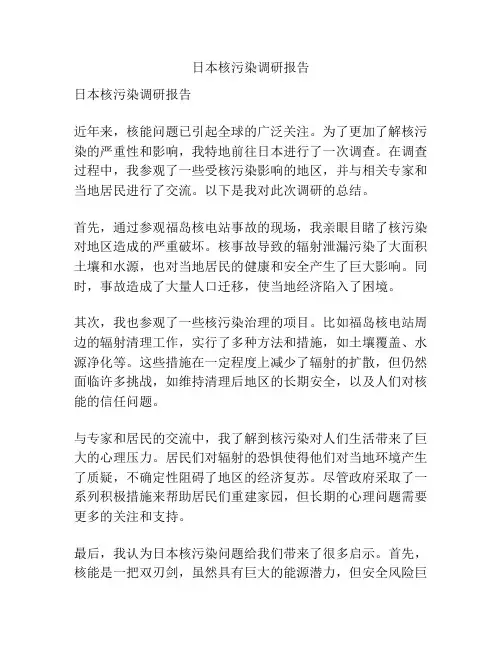
日本核污染调研报告日本核污染调研报告近年来,核能问题已引起全球的广泛关注。
为了更加了解核污染的严重性和影响,我特地前往日本进行了一次调查。
在调查过程中,我参观了一些受核污染影响的地区,并与相关专家和当地居民进行了交流。
以下是我对此次调研的总结。
首先,通过参观福岛核电站事故的现场,我亲眼目睹了核污染对地区造成的严重破坏。
核事故导致的辐射泄漏污染了大面积土壤和水源,也对当地居民的健康和安全产生了巨大影响。
同时,事故造成了大量人口迁移,使当地经济陷入了困境。
其次,我也参观了一些核污染治理的项目。
比如福岛核电站周边的辐射清理工作,实行了多种方法和措施,如土壤覆盖、水源净化等。
这些措施在一定程度上减少了辐射的扩散,但仍然面临许多挑战,如维持清理后地区的长期安全,以及人们对核能的信任问题。
与专家和居民的交流中,我了解到核污染对人们生活带来了巨大的心理压力。
居民们对辐射的恐惧使得他们对当地环境产生了质疑,不确定性阻碍了地区的经济复苏。
尽管政府采取了一系列积极措施来帮助居民们重建家园,但长期的心理问题需要更多的关注和支持。
最后,我认为日本核污染问题给我们带来了很多启示。
首先,核能是一把双刃剑,虽然具有巨大的能源潜力,但安全风险巨大。
其次,核事故对环境和人类生活的影响长期而且巨大,需要投入大量资源和精力进行治理和恢复。
同时,核污染的影响还会延续很长时间,需要在心理援助和长期监测方面加大力度。
总之,日本核污染调研让我深刻认识到核能问题的严重性和复杂性。
我们应该加强核能的安全管理和监督,同时积极推动非核能的发展。
另外,在核事故发生后,我们也需要给予受影响地区更多的支持和关注,包括治理、恢复和心理援助等方面。
只有全球合作和共同努力,才能更好地应对核污染问题,确保人类的生存和发展。
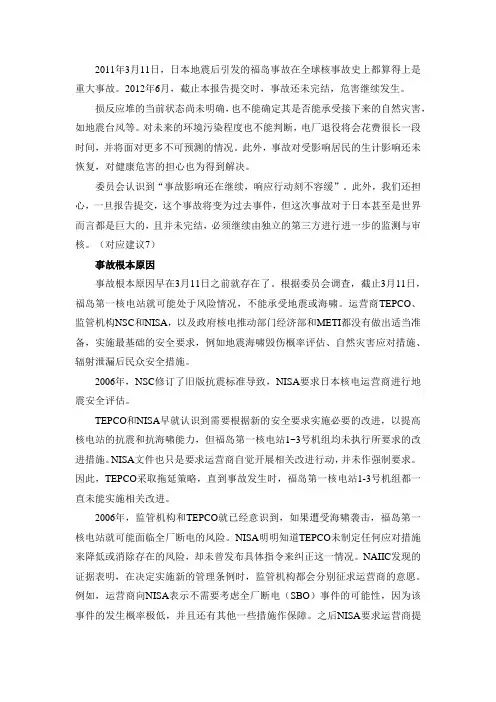
2011年3月11日,日本地震后引发的福岛事故在全球核事故史上都算得上是重大事故。
2012年6月,截止本报告提交时,事故还未完结,危害继续发生。
损反应堆的当前状态尚未明确,也不能确定其是否能承受接下来的自然灾害,如地震台风等。
对未来的环境污染程度也不能判断,电厂退役将会花费很长一段时间,并将面对更多不可预测的情况。
此外,事故对受影响居民的生计影响还未恢复,对健康危害的担心也为得到解决。
委员会认识到“事故影响还在继续,响应行动刻不容缓”。
此外,我们还担心,一旦报告提交,这个事故将变为过去事件,但这次事故对于日本甚至是世界而言都是巨大的,且并未完结,必须继续由独立的第三方进行进一步的监测与审核。
(对应建议7)事故根本原因事故根本原因早在3月11日之前就存在了。
根据委员会调查,截止3月11日,福岛第一核电站就可能处于风险情况,不能承受地震或海啸。
运营商TEPCO、监管机构NSC和NISA,以及政府核电推动部门经济部和METI都没有做出适当准备,实施最基础的安全要求,例如地震海啸毁伤概率评估、自然灾害应对措施、辐射泄漏后民众安全措施。
2006年,NSC修订了旧版抗震标准导致,NISA要求日本核电运营商进行地震安全评估。
TEPCO和NISA早就认识到需要根据新的安全要求实施必要的改进,以提高核电站的抗震和抗海啸能力,但福岛第一核电站1~3号机组均未执行所要求的改进措施。
NISA文件也只是要求运营商自觉开展相关改进行动,并未作强制要求。
因此,TEPCO采取拖延策略,直到事故发生时,福岛第一核电站1-3号机组都一直未能实施相关改进。
2006年,监管机构和TEPCO就已经意识到,如果遭受海啸袭击,福岛第一核电站就可能面临全厂断电的风险。
NISA明明知道TEPCO未制定任何应对措施来降低或消除存在的风险,却未曾发布具体指令来纠正这一情况。
NAIIC发现的证据表明,在决定实施新的管理条例时,监管机构都会分别征求运营商的意愿。
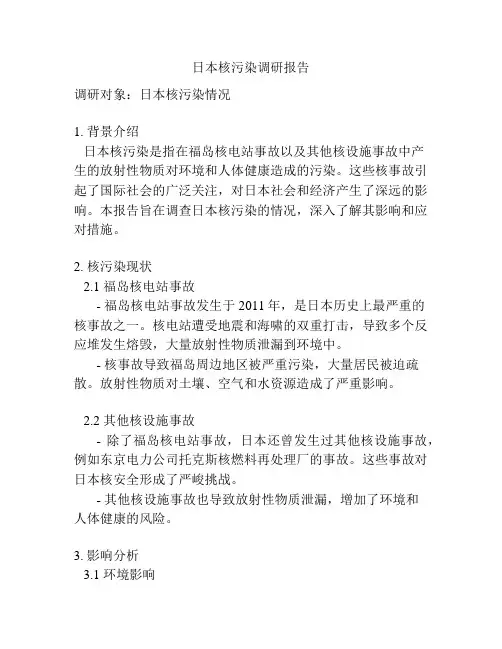
日本核污染调研报告调研对象:日本核污染情况1. 背景介绍日本核污染是指在福岛核电站事故以及其他核设施事故中产生的放射性物质对环境和人体健康造成的污染。
这些核事故引起了国际社会的广泛关注,对日本社会和经济产生了深远的影响。
本报告旨在调查日本核污染的情况,深入了解其影响和应对措施。
2. 核污染现状2.1 福岛核电站事故- 福岛核电站事故发生于2011年,是日本历史上最严重的核事故之一。
核电站遭受地震和海啸的双重打击,导致多个反应堆发生熔毁,大量放射性物质泄漏到环境中。
- 核事故导致福岛周边地区被严重污染,大量居民被迫疏散。
放射性物质对土壤、空气和水资源造成了严重影响。
2.2 其他核设施事故- 除了福岛核电站事故,日本还曾发生过其他核设施事故,例如东京电力公司托克斯核燃料再处理厂的事故。
这些事故对日本核安全形成了严峻挑战。
- 其他核设施事故也导致放射性物质泄漏,增加了环境和人体健康的风险。
3. 影响分析3.1 环境影响- 核污染对土壤、水资源和生态环境造成了长期污染和破坏。
污染区域的生态系统受到严重破坏,生物多样性遭受损失。
- 污染物还通过水系传播,影响了海洋生态系统。
海洋生物受到放射性物质的污染,对食物链和渔业产生了长期影响。
3.2 健康影响- 放射性物质对人体健康构成严重威胁。
辐射对人体细胞和基因造成损害,可能引发癌症、遗传变异和其他严重疾病。
- 污染地区居民的健康状况普遍较差,久病不愈和心理压力成为常态。
疏散居民面临着家园丧失、经济困难和社交隔离等问题。
4. 应对措施4.1 核污染清理- 日本政府重视核污染清理工作,在事故现场进行了大规模的核污染清理和土壤处理工作。
清理工作涉及清除放射性物质、修复土壤和恢复环境等方面。
- 清理工作取得了一定进展,但由于复杂的工程难度和巨大的经济压力,仍面临许多挑战。
4.2 环境监测与防护- 日本政府加强了对核设施的监督和安全管理,提高了核安全水平。
加强环境监测,及时掌握核污染的动态,采取必要的防护措施保护公众健康。
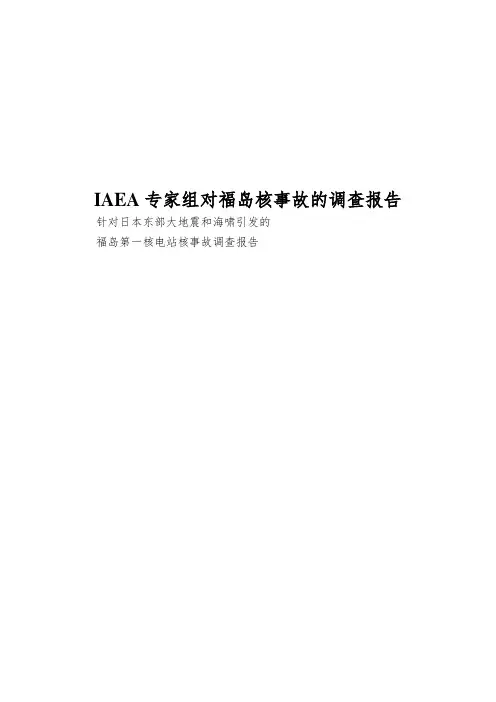
IAEA专家组对福岛核事故的调查报告针对日本东部大地震和海啸引发的福岛第一核电站核事故调查报告目录总结41、介绍101.1 背景 101.2 调查目的161.3 调查范畴161.4 调查的开展 172、导致福岛第一核电站的事故序列182.1 福岛第一核电站182.2 福岛第二核电站252.3 东海核电站 253、要紧成果、结论和体会教训263.1 引言 263.2 背景 263.3 国际原子能机构差不多原则:总述283.3.1 差不多安全原则3:核安全的领导和治理 29 3.3.2 差不多原则8:事故预防293.3.2.1 自然外部事件293.3.2.2 严峻事故313.3.3 差不多原则9:应急预备和响应333.3.3.1 场外应急预备以爱护公众和环境 333.3.3.2 场内应急打算以爱护工作人员353.4 国际原子能机构安全标准 363.5 国际原子能机构安全活动 363.4.1 复原路线图363.4.2 外部危机373.4.3 场外应急响应373.4.4 严峻事故情形下的大规模辐射防护组织373.4.5 后续IRRS审查384、致谢39总结2011年3月11日,日本东部发生9级大地震,地震引发一系列庞大海啸,突击了日本东部沿海。
最大浪高是在宫古岛的姉吉,达到38.9米。
地震和海啸给日本大片地区造成打击,15391人死亡,此外还有8171人下落不明。
大部分人口流离失所,他们生活的村镇被破坏或夷为平地。
许多基础设施也由于这次侵袭而瘫痪。
除了工业之外,许多核电站设施也由于严峻的地振动和大范畴的海啸而受到阻碍,包括东海、东通、女川、以及东电公司的福岛第一和第二核电站。
这些核电站在设计上都安装有自动停堆系统,在检测到地震时实现了机组成功停堆。
然而,庞大的海啸对这些核设施造成不同程度的阻碍,并导致东电公司的福岛第一核电站发生严峻事故。
尽管地震发生时,所有的厂外供电都差不多丧失,但东电公司福岛第一核电站的自动系统在检测到地震时成功地将所有操纵棒插入三个正在运行的反应堆,所有可用的应急柴油发电机也按设计处于运转状态。
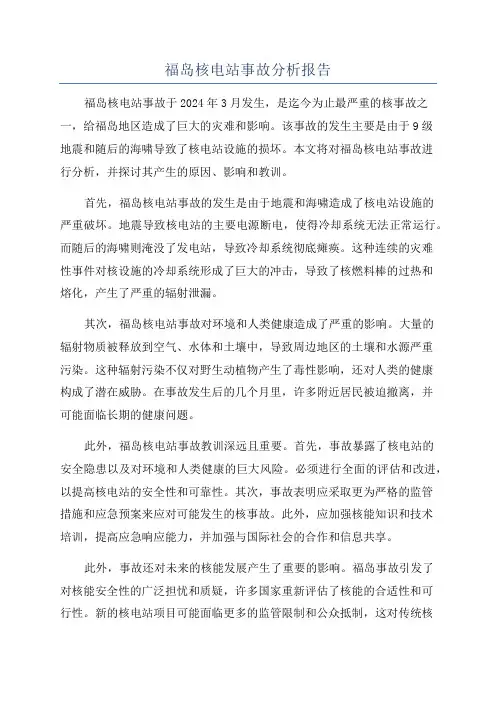
福岛核电站事故分析报告福岛核电站事故于2024年3月发生,是迄今为止最严重的核事故之一,给福岛地区造成了巨大的灾难和影响。
该事故的发生主要是由于9级地震和随后的海啸导致了核电站设施的损坏。
本文将对福岛核电站事故进行分析,并探讨其产生的原因、影响和教训。
首先,福岛核电站事故的发生是由于地震和海啸造成了核电站设施的严重破坏。
地震导致核电站的主要电源断电,使得冷却系统无法正常运行。
而随后的海啸则淹没了发电站,导致冷却系统彻底瘫痪。
这种连续的灾难性事件对核设施的冷却系统形成了巨大的冲击,导致了核燃料棒的过热和熔化,产生了严重的辐射泄漏。
其次,福岛核电站事故对环境和人类健康造成了严重的影响。
大量的辐射物质被释放到空气、水体和土壤中,导致周边地区的土壤和水源严重污染。
这种辐射污染不仅对野生动植物产生了毒性影响,还对人类的健康构成了潜在威胁。
在事故发生后的几个月里,许多附近居民被迫撤离,并可能面临长期的健康问题。
此外,福岛核电站事故教训深远且重要。
首先,事故暴露了核电站的安全隐患以及对环境和人类健康的巨大风险。
必须进行全面的评估和改进,以提高核电站的安全性和可靠性。
其次,事故表明应采取更为严格的监管措施和应急预案来应对可能发生的核事故。
此外,应加强核能知识和技术培训,提高应急响应能力,并加强与国际社会的合作和信息共享。
此外,事故还对未来的核能发展产生了重要的影响。
福岛事故引发了对核能安全性的广泛担忧和质疑,许多国家重新评估了核能的合适性和可行性。
新的核电站项目可能面临更多的监管限制和公众抵制,这对传统核能行业的发展将产生一定的影响。
与此同时,更多的国家也开始转向寻求可再生能源和清洁能源的替代方案,以减少对核能的依赖。
总之,福岛核电站事故是一次惨痛的教训,它向我们揭示了核能发展所面临的巨大风险和挑战。
这次事故迫使我们重新审视其安全性,并采取更严格的安全措施来保护环境和人类健康。
在未来的能源发展中,我们应该更加注重可持续和清洁能源的发展,减少对核能的依赖,并在技术和政策层面上加强风险评估和管理。
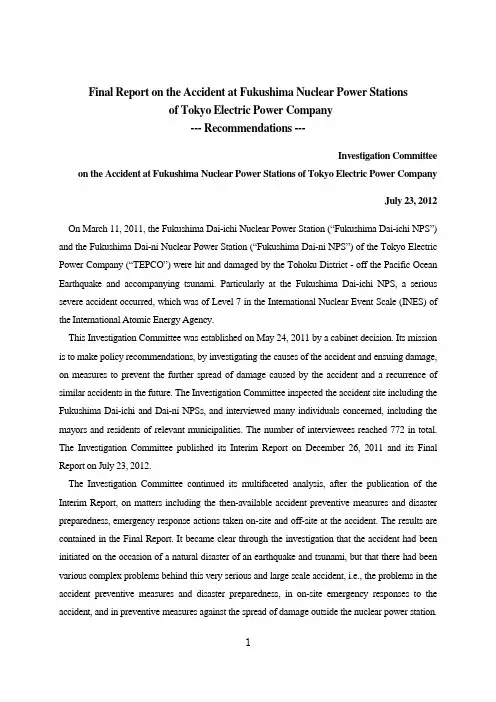
Final Report on the Accident at Fukushima Nuclear Power Stationsof Tokyo Electric Power Company--- Recommendations ---Investigation Committee on the Accident at Fukushima Nuclear Power Stations of Tokyo Electric Power CompanyJuly 23, 2012On March 11, 2011, the Fukushima Dai-ichi Nuclear Power Station (“Fukushima Dai-ichi NPS”) and the Fukushima Dai-ni Nuclear Power Station (“Fukushima Dai-ni NPS”) of the Tokyo Electric Power Company (“TEPCO”) were hit and damaged by the Tohoku District - off the Pacific Ocean Earthquake and accompanying tsunami. Particularly at the Fukushima Dai-ichi NPS, a serious severe accident occurred, which was of Level 7 in the International Nuclear Event Scale (INES) of the International Atomic Energy Agency.This Investigation Committee was established on May 24, 2011 by a cabinet decision. Its mission is to make policy recommendations, by investigating the causes of the accident and ensuing damage, on measures to prevent the further spread of damage caused by the accident and a recurrence of similar accidents in the future. The Investigation Committee inspected the accident site including the Fukushima Dai-ichi and Dai-ni NPSs, and interviewed many individuals concerned, including the mayors and residents of relevant municipalities. The number of interviewees reached 772 in total. The Investigation Committee published its Interim Report on December 26, 2011 and its Final Report on July 23, 2012.The Investigation Committee continued its multifaceted analysis, after the publication of the Interim Report, on matters including the then-available accident preventive measures and disaster preparedness, emergency response actions taken on-site and off-site at the accident. The results are contained in the Final Report. It became clear through the investigation that the accident had been initiated on the occasion of a natural disaster of an earthquake and tsunami, but that there had been various complex problems behind this very serious and large scale accident, i.e., the problems in the accident preventive measures and disaster preparedness, in on-site emergency responses to the accident, and in preventive measures against the spread of damage outside the nuclear power station.Examples are: the then-available accident preventive measures and disaster preparedness of TEPCO and the Nuclear Industry and Safety Agency (“NISA”) were insufficient against tsunami and severe accidents; the preparedness for a large-scale complex disaster was insufficient; and they were unprepared for the release of a large amount of radioactive materials into the environment caused by a containment failure. Inadequate TEPCO emergency responses to the accident at the site were also identified. Furthermore, in the preventive measures against the spread of damage taken by the central and local governments, problems were identified which lacked consideration to the victims, such as the radiation monitoring operation, the utilization of the System for Prediction of Environmental Emergency Dose Information (SPEEDI), evacuation instructions to the residents, responses to the people’s radiation exposure, or the provision of information to the nation and outside the country. In addition, problems of the crisis management system of the government came to light, too.The investigation thus far has suggested that radical strengthening revision be required of the measures for preventing a recurrence of a grave accident at the nuclear power station, and for limiting/mitigating the spread of damage. In this context, the Investigation Committee has made a number of recommendations in the Final Report (It also reproduces the recommendations made in the Interim Report).This document excerpts the recommendations which the Investigation Committee made in the Final Report. The Investigation Committee believes that the realization of these recommendations be useful and important for preventing a recurrence of a nuclear disaster and mitigating its damage. The central and local governments concerned, nuclear operators and other relevant organizations are strongly urged to incorporate and act upon these recommendations in their safety measures and disaster preparedness.The English version of the Interim Report of the Investigation Committee and its Executive Summary is available on the Committee’s website (http://icanps.go.jp/eng/). The English version of the Final Report and its Executive Summary will also be uploaded shortly.(1)Recommendations for a basic stance for safety measures and disaster preparednessRecommendations for disaster preparedness in light of complex disasters in mind (Final Report VI. 2. (2))When reviewing the existing safety measures at nuclear power stations, risks of a large scale complex disaster should be sufficiently considered in disaster preparedness.●Recommendations for changing an attitude to see risks (Final Report VI. 2. (3))i.It is necessary to humbly face the reality of natural threats, diastrophism and othernatural disasters, which are sizable in scale and time, keeping in mind that Japan has often had them in its long history.ii.Risk reduction should be tackled in a drastically different approach. In the government as well as in private entities, a new approach to safety measures and disaster preparedness should be established for a disaster which potentially brings about serious damage in broad areas like a gigantic tsunami or the severe accident at the Fukushima Nuclear Power Station, regardless of its probability of occurrence.iii.An institutional framework is needed to ensure continued in-depth examination of “residual risks” or “remaining issues” without leaving them behind beyond the predetermined safety measures and disaster preparedness.●Recommendations for “deficiency analyses from the disaster victims’ standpoint” (FinalReport VI. 2. (4))An accident at a nuclear power station has risks to bring about damage in vast areas.Nuclear operators on one hand, nuclear regulators on the other, should establish a systematic activity to identify all risk potentials from the “disaster victims’ standpoint,” when designing, constructing and operating such nuclear systems, for ensuring credible nuclear safety including evacuation planning in the local society. Such an approach should be practiced.Radioactive materials may scatter over vast areas due to an accident at a nuclear power station. The prefecture and local municipalities involved should closely collaborate in building up an effective system through evacuation planning and its drills for minimizing confusion.●Recommendations for incorporating the latest knowledge in the disaster prevention plan(Final Report VI. 2. (5))i.Scientific knowledge of earthquakes is not sufficient yet. The latest research resultsshould be continually incorporated in disaster preparedness. In other words, a policy/rule concluded at a certain point based on the then-available knowledge shouldbe reviewed with flexibility and revised, without groundless procrastination, when newknowledge of earthquakes and tsunami become available.ii.If an area is excluded, due to limited financial resources or other reasons, from the areas for strengthening disaster preparedness because of low or unknown probabilitiesof occurrence, the damage would be extremely serious once a massive earthquake andtsunami hit the area. Administrative bodies should take initiatives of, for instance,launching research projects on earthquake evaluation in specific areas for which someseismologists warn of risks, even if few in number, or which show traces of massiveearthquakes and gigantic tsunami (tsunami deposits, for instance) from the remotepast; or formulating an innovative disaster prevention plan in full cooperation of publicadministration, residents and experts through disclosing relevant information.iii.Disaster risks in nuclear power plant siting regions should be noted. It was the role of NISA to prepare for nuclear disasters at nuclear power stations. However, the policy ofthe Central Disaster Management Council has strong relevance to the disasterpreparedness at nuclear power stations. The Central Disaster Management Councilshould duly consider the nuclear power stations, too, in its policy making.(2)Recommendations for safety measures regarding nuclear power generation●Recommendations for building disaster prevention measures (Final Report VI 2 (1))Quite a number of issues exist, which need highly specialized nuclear knowledge over a wide range for solving technical and nuclear engineering problems concerning the emergency responses to the accident at TEPCO Fukushima Dai-ichi NPS, and the then-available disaster preparedness by the government, TEPCO and other organizations.These issues should be reviewed and resolved, results being shaped into concrete actions, through competent knowledge by stakeholders in nuclear power generation. In doing so, they should sincerely take into consideration the recommendations the Investigation Committee has made and they should do so with accountability to society for its process and results.●Recommendations for the necessity of comprehensive risk analysis (Final Report VI. 2. (4)a. (b))Nuclear facilities are installed in a natural environment, which is really diversified.Nuclear operators should conduct comprehensive risk analysis encompassing the characteristics of the natural environment including the external events, not only earthquakes and their accompanying events but also other events such as flooding, volcanic activities or fires, even if their probabilities of occurrence are not high, as well as the internal events having been considered in the existing analysis. Nuclear regulators should check the operators’ analysis. Nuclear operators should actively utilize currently available methods in their analyses of such external events, even if the Probabilistic Safety Assessment (PSA) approach is not firmly established for them. The government should consider support to promote relevant research programs for such initiatives.●Recommendations for severe accident management (Final Report VI. 1. (4) a. (c))In order to ensure maintaining nuclear safety at nuclear power stations, vulnerability of individual facilities for a wide range of characteristics of various internal and external events should be identified by comprehensive safety analysis, and appropriate measures (severe accident management) against such vulnerability should be examined and placed in shape, assuming a situation in which the core may have serious damage by an accident far exceeding the design basis. The effectiveness of such severe accident management should be evaluated through the PSA or other means.(3)Recommendations for nuclear disaster response systems●Recommendations for reforming the crisis management system for a nuclear disaster (FinalReport VI. 2. (6))Learning from the experience as a result of the accident at the Fukushima Dai-ichi NPS, the crisis management system for a nuclear disaster should be urgently reformed, in which the nuclear emergency response manual should be revised assuming an occurrence of a complex disaster combining an earthquake/tsunami disaster and a nuclear accident. In its reforming process, the strengthening of response capabilities of off-site centers, which are supposed to serve as the base for response during a nuclear emergency (hereafter simply referred to as “off-site centers”), is needed. In addition, it is also required to build a crisis management system by examining how to respond to a situation which a Local NuclearEmergency Response Headquarters cannot handle by convening personnel from relevant emergency responsebodies.●Recommendations for the nuclear emergency response headquarters (Final Report VI. 2. b.(a))The emergency response headquarters should, in general, be located close to the accident site where the relevant information is easy to obtain in a nuclear emergency, and the activities at the accident site are easy to grasp. To promptly collect accurate information is, needless to say, the fundamental principle in a nuclear emergency. The government emergency response headquarters should be set up in a way which enables the government people access to the necessary information while staying in government facilities like the Prime Minister’s Office, without moving to the nuclear operator’s head office.●Recommendations for off-site centers (Interim Report VII. 3. (1) a.)The Government should take prompt actions to ensure that off-site centers are able to maintain their functions even during a major disaster, learning from the fact that the Off-site Center (in Fukushima) became unusable because the risks of radioactive contamination had not been adequately considered beforehand.●Recommendations for the roles of the prefectural government in nuclear emergencyresponses (Final Report VI. 1. (2) c.)In a nuclear disaster, the prefectural government should take a responsible role in front, because the damage can extend to a regional size. The nuclear disaster prevention plan should take this point into account.(4)Recommendations for damage prevention and mitigation●Recommendations for the provision of information and risk communication (Final ReportVI. 2. (7))It is necessary to build mutual trust between the public and the government and to provide relevant information in an emergency while avoiding societal confusion and mistrust. To this end, a risk communication approach on risks and opinion exchanges thereupon should be adopted for a consensus building among all stakeholders based on mutual trust. The government should examine, by institutionalizing an appropriate body,how to provide relevant information in an emergency to the public, promptly, accurately, and in an easily understandable as well as clear-cut (not misleading) manner. Inappropriate provision of information can lead to unnecessary fear among the nation. Therefore, an expert on crisis communication may be assigned for providing appropriate suggestions to the cabinet secretary responsible for information provision to the public in an emergency.●Recommendations for improving radiation monitoring operations (Interim Report VII. 5.(2) d.)i.To ensure that the monitoring system does not fail at critical moments, and to ensurethe collection of data and other functions, the system should be designed against various possible events, including not only an earthquake but also a tsunami, storm surge, flood, sediment disasters, volcanic eruptions and gale force winds. Measures should be taken to prevent the system from functional failures even in a complex disaster simultaneously involving two or more such events. Furthermore, measures should be developed to facilitate the relocation of monitoring vehicles and their patrols even in a situation where an earthquake has damaged roads.ii.Training sessions and other learning opportunities should be enhanced to raise awareness of the functions and importance of the monitoring system among competent authorities and personnel.●Recommendations for the SPEEDI system (Interim Report VII. 5. (3) c.)In order to protect the lives and dignity of residents caught up in a disaster, and to prevent the spread of harm from the disaster, measures should be developed to improve operational guidelines of the SPEEDI system so that crucial information on radiation dose rates is provided promptly in a manner acceptable to the people. Measures, including hardware and infrastructure-related measures should be developed and implemented to ensure that SPEEDI functions remain operable even during a complex disaster.●Recommendations for evacuation procedures of residents (Items i. to iv. in Interim ReportVII. 5. (4) c. and item v. in Final Report VI. 1. (4) b.)i.Activities to raise public awareness in daily lives are needed to provide residents withbasic, practical knowledge of how radioactive substances are released during a major nuclear accident, how they are dispersed by wind and other agents, and how they fallback to the ground, as well as knowledge of howthe exposure to radiation can affect human health.ii.Local government bodies need to prepare evacuation readiness plans that take into account the exceptionally grave nature of a nuclear accident, periodically conduct evacuation drills in a realistic circumstance, and take steps to promote the earnest participation of residents in those drills.iii.It is necessary to complete, during normal times, readiness preparations, such as drafting detailed plans for ensuring means of transportation, traffic control, securing evacuation sites in outlying areas, and securing water and food supplies at the evacuation site, taking into consideration the situation that the evacuees may number in the thousands to over a hundred thousand . It is especially important to develop measures that support the evacuation of the disadvantaged, such as seriously ill or disabled people in medical institutions, homes for the aged, social welfare facilities, or in their own homes.iv.The above types of measures should not be left up to the local municipal governments, but need in addition to involve the active participation of the prefectural and national governments in designing and operating an evacuation plan and a disaster prevention plan, in consideration of the situation that a nuclear emergency would affect a large area.v.The existing Emergency Planning Zone (EPZ) had been set before the accident on the basic assumption of 8 to 10 km from a nuclear power station, so that the situation could be well dealt with even in an incident far exceeding a hypothetical accident. However, the accident has shown the need to reconsider what accidents to assume and how to designate evacuation areas. Furthermore, the roles of the government in a nuclear emergency are so large that the government responses should not be limited to those areas outside nuclear site boundaries such as the residents’ evacuation. It should also be considered what the government should do to cooperate or support the nuclear operator in a nuclear emergency, in consultation with the operator.Recommendations for administering stable iodine tablets (Final Report VI. 1. (3) e. (c)) In the existing emergency preparedness, administration of stable iodine tablets is, inprinciple, subject to the judgment of the government NERHQ. A system which allows local municipalities to independently administer the tablets should be reconsidered, and so is the appropriateness to distribute them in advance to the residents as a precaution.●Recommendations for radiation emergency medical care institutions (Final Report VI. 1. (3)e. (f))A considerable number of medical facilities for initial radiation emergency medicaltreatment should be located in the area which is not likely to be included in an evacuation designated area, so that radiation emergency medical care could be provided even in a severe accident like the accident at Fukushima Dai-ichi NPS. Those medical facilities should not be concentrated in the area close to the nuclear power station. At the same time, such medical care systems in a nuclear emergency would need to be coordinated for collaborating over a wide area across the prefectural borders.●Recommendations for public understanding of radiation effects (Final Report VI. 1. (3) e.(g))As many opportunities as possible should be institutionalized for the public to get knowledge and deepen their understanding of radiation. By doing so, the individuals should be able to judge the radiation risks based on correct information; in other words, they would be freed from unnecessary fears about, or from underestimating, the radiation risks because of the lack of information.●Recommendations for information sharing with, and receiving support from, overseas(Final Report VI. 1. (3) g. (a), (b))Provision of information to overseas countries is equally important as to the Japanese public, especially to neighboring countries or those countries which have many of their nationals residing in Japan. Active and polite responses should be in place for prompt and accurate provision of relevant information with due consideration to language barriers.International support in a nuclear emergency should be accepted and received as early as possible, when offered, for international comity and for urgently meeting national needs. To avoid confusion and inappropriateness experienced in the early stages at the time of the accident in Fukushima, operation manuals of competent ministries, nuclear operator emergency management operation plans and other relevant materials should prescribe howto respond to such international support.(5)Recommendations for harmonization with international practices●Recommendations for harmonization with international practices such as the IAEA safetystandards (Final Report VI. 1. (7))It is necessary to keep the national regulation qualities constantly updated in line with the nuclear knowledge accumulation and technological development in the international and national community. To this end, continuous efforts are needed to keep the national regulatory guides newest and best while monitoring international standards, such as those at the IAEA. Lessons on nuclear safety should be extracted from the accident, and those lessons and relevant knowledge should be provided to the international community so that they could contribute to the prevention of similar accidents, not only in our country but also in other countries. In the process of revising national regulatory guides, international contribution should be pursued by making efforts to propose them to incorporate into the IAEA standards etc., if they turn out to be effective and useful as international standards.(6)Recommendations for relevant organizations●Recommendations for the nuclear safety regulating body.i.The need for independence and transparency(Interim Report VII. 8. (2) a.)An organization with regulatory oversight over nuclear safety must be able to makedecisions effectively and independently, and must be able to function separately from anyorganization that could unduly influence its decision-making process. The new nuclearsafety regulatory organization should therefore be granted independence and shouldmaintain transparency.The new nuclear safety regulatory organization must be granted the authority, financialresources and personnel it needs to function autonomously as an entity concerned withnuclear safety and should also be given the responsibility of explaining nuclear safetyissues to the Japanese people.anizational preparedness for swift and effective emergency response (Interim Report VII. 8. (2) b.)In light of the serious impact of a nuclear disaster on the nation, the nuclear safety regulatory organization, which would play a key role in disaster response, should, during normal times, work out a disaster prevention plan and implement emergency response drills to facilitate rapid response if a disaster occurs. Furthermore it should foster the specialized skills to provide individuals and organizations responsible for emergency response with expert advice and guidance, and should foster as well the management potential to utilize organizational resources effectively and efficiently.In addition, the nuclear safety regulatory organization must be well aware that its role is to respond responsibly to crises. It should beforehand prepare systems that can deal with a major disaster if it occurs, and develop partnerships with relevant government ministries and agencies and with relevant local governing bodies to create mechanisms for cross-organizational response, with the role of the nuclear safety regulatory organization clearly demarcated.iii.Recognition of its role as a provider of disaster-related information to Japan and the world (Interim Report VII. 8. (2) c.)The new nuclear safety regulatory organization must be fully conscious that the way it provides information is a matter of great importance, and must also, during normal times, establish an organizational framework that enables it to provide information in a timely and appropriate manner during an emergency.iv.Development of competent human resources and specialized expertise (Interim Report VII. 8. (2) d.)The new nuclear safety regulatory organization should consider establishing a personnel management and planning regime that encourages personnel to develop lifetime careers. For example, it should offer improved working conditions to attract competent human resources with excellent specialized expertise, expand opportunities for personnel to undergo long-term and practical training, and promote personnel interaction with other administrative bodies and with research institutions, including those involved in nuclear energy and radiation.v.Efforts to collect information and acquire scientific knowledge (Interim Report VII. 8.(2) e.)The new nuclear safety regulatory organization to be established should keep abreast of trends embraced by academic bodies and journals in the field (including those in foreign countries) and by regulatory bodies in other countries, in order to continue acquiring knowledge that will contribute to its regulatory activities. It must also understand the implications of that knowledge, systematically share and sufficiently utilize such knowledge, and resulting outcomes should be archived and continually utilized as an organization.vi.Active relationship with international organizations and regulatory bodies of other countries (Final Report VI. 1. (5))The fixed number of personnel at a government administrative organization is a collective issue of the all administrative organizations, and not limited to an issue of NISA, etc. But that of the new regulatory body should be duly considered, because of the importance of nuclear safety. The new regulatory body should secure its personnel, should establish an organizational system competent for international contribution, and develop human resources who can take a role in personnel interaction with international organizations or regulatory bodies of other countries.vii.Strengthening of the regulatory body (Final Report VI. 1. (5))In order to ensure nuclear power safety, responses to individual problems encountered are not sufficient. Continuous efforts are needed to keep national regulatory guides updated at their newest and best qualities, with consideration to international trends of safety regulations and nuclear security, not only to the latest scientific knowledge in the country and overseas. Considering that the impact of a nuclear disaster on society can be sizable, emergency preparedness should be fully established during normal times by formulating a disaster prevention plan or by conducting nuclear emergency response drills so that effective and prompt responses could be taken in an emergency. The regulatory organization should foster the specialized skills to provide individuals and organizations responsible for emergency response with expert advice and guidance and should also foster the management potential to utilize organizational resources effectively and efficiently. Appropriate size of budget and human resources should be duly examined.●Recommendations for TEPCO (Final Report VI. 6. e.)TEPCO bears critical responsibilities to society as a nuclear operator primarily responsible for nuclear power plant safety. Nevertheless, TEPCO was not sufficiently prepared for such an accident, that natural disasters including tsunami may lead to large-scale core damage. Furthermore, TEPCO had not taken adequate preparedness for tsunami risks beyond design basis at the Fukushima Dai-ichi NPS. The accident showed quite a number of problems with TEPCO such as insufficient capability in organizational crisis management; hierarchical organization structure being problematic in emergency responses; insufficient education and training assuming severe accident situations; and apparently no great enthusiasm for identifying accident causes. TEPCO should receive with sincerity the problems which the Investigation Committee raised and should make further efforts for solving these problems and building higher level safety culture on a corporate-wide basis.●Recommendations for rebuilding safety culture (Final Report VI. 2. (8))Well established safety culture is vitally important to people’s lives in the nuclear power industry, which may cause serious situations once an accident occurs. In view of the reality that safety culture was not necessarily established in our country, the Investigation Committee would strongly require rebuilding safety culture of practically every stakeholder in nuclear power generation such as nuclear operators, regulators, relevant institutions, and government advisory bodies.(7)Recommendations for continued investigation of accident causes and damage●Recommendations for continued investigation of accident cause (Final Report VI. 2. (9) a.)The government, nuclear operators, nuclear plant manufacturers, research institutions, academies, all such stakeholders (relevant organizations) involved in nuclear power generation should take active roles in investigating the accident and in fact analyses, and continue, in their respective capacities, their comprehensive and thorough investigations of the remaining unresolved problems. The government, in particular, should not conclude its investigations of the Fukushima nuclear accident at the time when this Investigation Committee or the Fukushima Nuclear Accident Independent Investigation Commission。

⽇本福岛核电站事故分析报告⽇本福岛核电站事故分析报告论软件⼯程管理常见问题事件回顾:当地时间3⽉11⽇14时46分,⽇本发⽣⾥⽒9级地震,震中位于宫城县以东的太平洋海域,震源深度20公⾥.地震引发的10⽶浪⾼⼤海啸随后横扫沿海地区.地震发⽣后,宫城县、福岛县的数所核电站⾃动关闭。
虽然核裂变被终⽌,但核反应堆还需要数天的冷却才可以完全关闭。
⽽随后⽽来的海啸损坏了福岛核电站冷却系统的紧急供电系统,导致反应堆冷却系统失效。
当地时间3⽉12⽇下午15时36分左右,福岛第⼀核电站1号机组发⽣爆炸,4⼈受伤,反应堆燃料可能发⽣熔化,官⽅要求⽅圆10公⾥范围内的居民紧急疏散,晚些时候将范围扩⼤到20公⾥。
当地时间3⽉14⽇上午11时左右3号机组发⽣爆炸。
当地时间3⽉15⽇晨6时10分左右,2号机组发⽣爆炸。
当地时间3⽉15⽇11时左右3号机组再次发⽣爆炸,4号机组起⽕,造成⼤量辐射物泄露。
到⽬前为⽌,⽇本还在积极处理此次核事故。
看到这些,我们可以说这是⼀次天灾。
但我更觉得这个是⼀次“⼈祸”,中间有许多设计和实施上的缺陷,导致此次事故的扩⼤。
由此我想到我们在实施⼀个⼤型软件项⽬的时候,我们也会经常遇到的⼀些问题,我把它罗列出来,⼀⼀加以说明。
1、架构选型发⽣事故的福岛核电站是当今世界上最⼤的核电站,位于⽇本福岛⼯业区,由福岛⼀站、福岛⼆站组成,共有10台机组,⼀站6台,⼆站4台,均为沸⽔堆,总输出功率为9096兆⽡。
福岛⼀站1号机组于1967年9⽉动⼯,1970年11⽉并⽹,福岛⼆站4号机组于1987年投⼊运⾏。
简单介绍下核电的知识,核电的核⼼核反应堆⽬前主要有压⽔堆和沸⽔堆两种。
压⽔堆有两个回路,⼀回路⾥的⽔被核燃料直接加热,然后流到热交换器⾥,冷却后再流回到反应堆来冷却核燃料,如此循环,不断带⾛核燃料产⽣的热。
通过热交换器⼀回路⾥的⾼温去加热⼆回路⾥的⽔,使其产⽣蒸汽来驱动涡轮发电机来发电。
⼀回路⾥是有辐射性的,⽽⼆回路⾥是没有辐射性的。
福岛核事故调查报告
福岛核事故调查报告
背景信息
•事故发生时间:2011年3月11日
•事故地点:日本福岛县
•事故原因:地震引发的海啸导致核电站设施损坏,引发核泄漏事故概述
•核电站概况:福岛第一核电站是一座由6个核反应堆组成的核电站,事故发生时其中4个堆已投入运营。
•地震与海啸:2011年3月11日发生的东北地方太平洋沖地震引发了10米高的海啸,严重损害了核电站的设施。
•核泄漏:海啸造成核电站的冷却系统严重受损,导致核反应堆过热并发生氢气爆炸,引发核泄漏。
事故调查与分析
•事故根本原因:事故的根本原因在于核电站对地震和海啸的防护措施不足,未能预防海啸对设施的破坏。
•事后调查:事故发生后,福岛核电站事故调查委员会进行了详细调查,分析了事故发生及其原因。
•调查结论:调查报告指出,核电站的设计未考虑到可能发生的大型海啸,且应急反应措施不完备,导致事故发生及其严重后果。
事故的教训与影响
•核能安全规范:福岛核事故引起了全球对核能安全的广泛关注,各国纷纷加强核电站的安全规范,提高对地震和海啸等自然灾害的抵抗能力。
•代价与后果:事故导致数千人死亡、失踪以及核辐射对环境的长期影响,同时也给日本经济和能源政策带来了巨大的冲击。
•反思与改进:事故促使日本重新审视并改善其核能发展战略,重视安全问题,加快发展可再生能源,减少对核能的依赖。
总结与展望
福岛核事故是人类历史上最严重的核事故之一,其给人们带来了深刻的反思和警醒。
各国应共同努力,加强核能安全管理和应急响应能力,以确保人类的生命和环境不受核能发展的副作用影响。
同时,也要推动可再生能源的发展,实现清洁、可持续的能源未来。
IAEA专家组对福岛核事故的调查报告国际原子能机构(IAEA)派遣的专家组对2024年福岛核事故进行了调查和评估,并于最终版报告中总结了他们的发现和建议。
该调查报告包含了事故的原因、影响和吸取的教训,对于日本政府和国际社会都具有重要的参考价值。
调查报告首先指出,福岛核事故是由于地震和海啸导致核电站失去冷却功能而发生的。
事故暴露了日本核电站在面对这种自然灾害时的脆弱性和缺乏应急准备措施。
报告指出,对于核电站的设计和建设,需要对地震和海啸的潜在影响进行更全面和准确的评估。
此外,报告还强调,核电站应该制定针对自然灾害的详细应急计划,并进行定期训练和演习。
报告还指出,福岛核事故造成了广泛的环境和人类健康影响。
事故导致了大量的核辐射释放,造成附近地区的严重污染。
报告建议,政府应加强对受影响地区的监测和治理措施,确保核辐射的最小化和公众的安全。
此外,报告还建议加强与国际社会的合作,分享有关核辐射的信息和经验,以提高核灾害应对能力。
在教训和改进方面,报告提出了一系列建议。
首先,报告强调了核安全文化的重要性,强调核电站人员的培训和安全意识的提高。
其次,报告建议加强监管机构的角色和责任,确保核电站的运营和管理符合国际标准。
此外,报告还呼吁加强核事故应对和紧急情况的合作,并提供国际援助和支持。
最后,报告总结道,福岛核事故是一次引人深思的事件,对于全球核能行业和核安全事务具有重要的启示。
报告指出,核能是一种重要的清洁能源,但同时也伴随着风险和挑战。
因此,全球需要加强对核电站的管理和监管,并推动技术的发展和创新,以提高核能的安全性和可持续性。
总的来说,IAEA专家组对福岛核事故的调查报告提供了一个全面而深入的分析,对于吸取教训、改进核电站的安全性和应对核灾害具有重要的指导意义。
同时,报告也强调了国际合作和共享信息的重要性,以共同应对核能发展中的挑战和风险。
福岛核事故的调查报告•事故概述•事故原因分析•事故应对措施与救援•事故后果与社会影响•事故调查与总结经验教训•相关责任追究与法律程序•前瞻性研究与发展建议目录事故发生时间与地点2011年3月11日,日本福岛县发生地点福岛第一核电站7级核事故,属于国际最高级别核事故之一。
事故规模影响范围影响时间放射性物质泄漏至大气中,影响到周边地区,包括日本其他县市,甚至影响到邻国。
持续数月,对周边地区的环境和人类健康造成了长期影响。
030201事故的规模与影响福岛核电站设有预警系统,但预警系统在事故发生时没有正常工作。
预警系统日本政府和核电站运营方对核事故的应对准备不足,缺乏应对大规模核事故的经验和措施。
准备不足政府部门和运营方在事故发生后未能及时向公众通报事故情况,导致公众对信息的获取不及时、不充分。
信息沟通不畅事故前的预警与准备福岛核电站设备存在老化和磨损的问题,这使得设备在地震和海啸的冲击下更容易发生故障。
设备老化核电站设备需要定期维护和检查,但实际上,设备的维护并不到位,这使得设备在关键时刻容易出问题。
维护不当设备老化与维护不当地震影响福岛核电站所在地区曾发生过大地震,这使得核电站设备受到严重损坏,进而导致事故的发生。
海啸冲击福岛核电站所在地区也是海啸的多发区,然而,核电站并未针对可能发生的海啸进行充分的预防和应对措施,导致海啸对核电站造成了严重的影响。
地震与海啸的冲击福岛核电站的设计存在一些缺陷,例如安全壳结构不合理、冷却系统失效等,这些因素都增加了事故发生的可能性。
福岛核电站的安全标准并未达到国际先进水平,这也为事故的发生埋下了隐患。
核电站设计与安全缺陷安全标准不足设计问题在事故发生过程中,操作人员的判断失误、操作不当等问题也是导致事故扩大的原因之一。
操作失误核电站的指挥系统也存在一些问题,例如信息传递不畅、决策不及时等,这些问题都影响了事故的应对和处置。
指挥不当人员操作失误与指挥不当紧急疏散与撤离计划紧急疏散在事故发生后,福岛核电站周边地区的居民被紧急疏散,以避免放射性物质泄漏可能带来的伤害。
国际原子能机构国际事实调查专家组针对日本东部大地震和海啸引发的福岛第一核电站核事故调查报告目录总结 (4)1、介绍 (13)1.1 背景 (13)1.2 调查目的 (23)1.3 调查范围 (23)1.4 调查的开展 (24)2、导致福岛第一核电站的事故序列 (25)2.1 福岛第一核电站 (25)2.2 福岛第二核电站 (36)2.3 东海核电站 (37)3、主要成果、结论和经验教训 (38)3.1 引言 (38)3.2 背景 (39)3.3 国际原子能机构基本原则:总述 (42)3.3.1 基本安全原则3:核安全的领导和管理 (42)3.3.2 基本原则8:事故预防 (43)3.3.2.1 自然外部事件 (43)3.3.2.2 严重事故 (46)3.3.3 基本原则9:应急准备和响应 (50)3.3.3.1 场外应急准备以保护公众和环境 (50)3.3.3.2 场内应急计划以保护工作人员 (52)3.4 国际原子能机构安全标准 (53)3.5 国际原子能机构安全活动 (54)3.4.1 恢复路线图 (55)3.4.2 外部危机 (55)3.4.3 场外应急响应 (56)3.4.4 严重事故情况下的大规模辐射防护组织 (56)3.4.5 后续IRRS审查 (56)4、致谢 (59)总结2011年3月11日,日本东部发生9级大地震,地震引发一系列巨大海啸,袭击了日本东部沿海。
最大浪高是在宫古岛的姉吉,达到38.9米。
地震和海啸给日本大片地区造成打击,15391人死亡,此外还有8171人下落不明。
大部分人口流离失所,他们生活的村镇被破坏或夷为平地。
许多基础设施也由于这次侵袭而瘫痪。
除了工业之外,许多核电站设施也由于严重的地振动和大范围的海啸而受到影响,包括东海、东通、女川、以及东电公司的福岛第一和第二核电站。
这些核电站在设计上都安装有自动停堆系统,在检测到地震时实现了机组成功停堆。
但是,巨大的海啸对这些核设施造成不同程度的影响,并导致东电公司的福岛第一核电站发生严重事故。
虽然地震发生时,所有的厂外供电都已经丧失,但东电公司福岛第一核电站的自动系统在检测到地震时成功地将所有控制棒插入三个正在运行的反应堆,所有可用的应急柴油发电机也按设计处于运转状态。
第一波海啸浪潮在地震发生后46分钟到达福岛第一核电站。
海啸浪潮冲破了福岛第一核电站的防御设施,这些防御设施的原始设计能够抵御浪高5.7米的海啸,而当天袭击电站的最大浪潮预计超过14米。
海啸浪潮深入到电站内部,造成除一台应急柴油发电机(6B)之外的所有电源丧失,厂内和厂外都丧失了可用的重要供电,且外部援助无望。
福岛第一核电站出现全厂断电,海啸又导致1-4号机组的所有仪控系统全部失灵,只有应急柴油发电机6B能向5号和6号机组提供应急电源。
海啸及裹挟的大量残毁物对厂房、大门、道路、储存罐和其他厂内基础设施造成重大破坏,包括热阱的丧失。
操作员面临着前所未有的灾难性紧急情况,丧失了供电、反应堆控制或仪控。
此外,厂内厂外的通信系统也受到严重影响。
在几乎没有仪控系统的情况下,他们只能在黑暗中尽力维持6个反应堆、6个乏燃料池,1个共用燃料池和干式乏燃料储存设施的安全。
由于没有办法来控制或冷却反应堆机组,在地震发生时还在运行的福岛第一核电站的3个机组在反应堆衰变热的作用下迅速升温,虽然操作人员勇敢地尝试了新方法来恢复对反应堆和乏燃料池的控制和冷却,但还是发生了燃料严重损毁和一系列爆炸。
这些爆炸对电站造成进一步破坏,使操作员面临的情况更加严峻和危险。
此外,放射性污染还扩散到环境中。
根据国际核事故分级系统初步确定这些事件为最高级别的核事故。
目前,还没有关于此次核事故的放射性泄漏对人体健康影响的报告。
按照与日本政府的协定,国际原子能机构组织了初步调查组,探究事实真相并从此次福岛核事故中汲取初步的经验教训,同时将这些信息在国际核能社会中公布。
为此,一个专家组承担了此次调查任务,时间从5月24日至6月1日。
此次调查结果将向2011年6月20-24日在维也纳国际原子能机构总部举行的部长级核安全大会进行汇报。
这份初步总结报告将向日本政府提供直接的反馈。
在调查期间,这支由核专家组成的队伍得到了各方的积极配合,从许多相关的日本政府机构、核电监管部门和运营单位得到了有关信息。
调查组还走访了三个受影响的核电设施,包括东海第二核电站、东电公司福岛第一核电站和第二核电站,以便了解电站的现状和损坏情况。
到设施实地考察使得专家们能够与操作员进行交流,并了解正在进行的恢复和补救工作。
调查组收集了证据、进行了初步评价并得出了初步的总结和经验教训,这些初步的总结和经验教训已经与日本专家和官员进行了讨论和共享。
它们主要涉及三个专业领域,即外部灾害、严重事故管理和应急准备。
这些对于日本核电行业和国际原子能机构很有现实意义,也有助于国际核能社会从中汲取经验教训以提高核安全。
IAEA调查组敦促国际核能社会考虑下列15个调查结论和16个经验教训,充分利用此次福岛核事故特有的机会,学习并提高国际范围的核能安全。
结论1:国际原子能机构基本安全原则为应对福岛核事故提供了坚实的基础,并且涵盖了此次事故经验教训的各个领域。
结论2:面对此次事故的极端情况,当地应急组织已经按照基本原则3进行了最大程度的管理。
结论3:对海啸灾害没有充分的纵深防御预案,尤其是:●按照调查组会议中的介绍,虽然福岛第一核电站在选址评估和设计中都考虑了海啸灾害,并且海啸的可能高度在2002年以后也被调高(许可证文件未作更改),但是海啸灾害仍然被低估。
●考虑到现实中这些运行核电站不是“干厂址”,在2002年评估后采取的额外防御措施不足以应对海啸的爬高水位以及次生灾害性现象(流体动力和大残毁物的高能撞击)。
●这些补充保护措施没有经过核安全监管当局的审评和批准。
●由于受洪水影响的系统结构和部件(SSC)故障通常不是线性递增的,电站不能够承受超过预期的海啸高度所导致的后果(陡边效应),以及●严重事故管理预案不足以应对多机组故障。
结论4:对东海2号和福岛第二核电站,从短期看,应针对电站和厂址目前的情况(由地震和海啸引发)以及已改变的外部灾害重新评估电站的安全性。
尤其要注意的是,如果外部事件的PSA模型已经完成,这将有助于开展评估。
福岛第一核电站的短期措施需要进行规划,直到所有机组恢复安全稳定。
应使用简单的方法来确认抵御外部灾害的优先性措施,以便及时完成规划。
预防性措施固然重要但也有局限,规划中应包括厂内和厂外缓解措施。
一旦达到冷停堆稳定状态,就需要制定长期规划,包括对系统结构部件(SSC)的实体改进和厂内厂外的应急措施。
结论5:应当更新监管规定和导则,以体现此次东日本大地震中获得的经验和数据,并采用国际原子能机构安全相关标准确立的准则和方法来全面应对海啸以及所有相关联的外部事件。
各国监管文件应当包含与国际原子能机构安全标准相一致的数据库要求。
用于灾害评价和电厂保护的方法应与相关领域的研发进展相一致。
结论6:日本有组织良好的应急准备和响应体系,这体现在福岛核事故的处理过程中。
但是复杂的结构和组织体系可能导致紧急决策的拖延。
结论7:忠于职守、勇于奉献的干部和工作人员,再加上组织良好和灵活的系统,即使在超出预计的情况下也可以有效的做出响应,并防止事故进一步对公众和设施内工作人员的健康产生更大影响。
结论8:后续适当的开展公众辐照和健康监测项目将十分有益。
结论9:虽然事件造成严重影响,但对受影响电站的放射性辐照的控制似乎很有效。
结论10:重新审议国际原子能机构安全标准,确保其能够充分地覆盖一站多机组厂址的设计及其严重事故管理的特殊要求。
结论11:有必要定期使国家的法规和导则与国际标准和导则保持一致,特别是吸取世界各地遭外部灾害影响得出的新经验教训。
结论12:IAEA的地震安全中心(ISSC)开展的安全审查能够有效地帮助日本在下述领域开展工作:●外部事件风险评估;●电站停堆后重启的准备工作;●震前准备。
结论13:包括应急准备审查(EPREV)在内的后续调查组应深入研究场内场外应急响应的经验教训。
结论14:开展后续调查,以寻求从福岛事故后为提供大规模辐射防护而采取的有效行动中汲取经验。
结论15:在2007年日本IRRS报告基础上开展后续调查,掌握福岛核事故经验教训,汇总上述结论,促进日本核安全监管系统的完善。
教训1:需要确保在外部自然灾害中:●核电站的选址和设计应足以抵御罕见的和复杂组合的外部事件,并在电站安全分析中加以考虑,尤其是那些可能导致电站水淹和引发长期影响的事件。
●电站布局应基于维持“干厂址理念”,尽可能的设置纵深防御措施抵御电站被淹,并保持关键安全系统的实体隔离和多样性。
●共性原因导致的故障应作为一站多堆和多个电站的重点考虑内容,要保证独立的机组恢复可以使用所有的厂内资源。
●定期审议外部事件灾害的变化或对其的认知水平,以便考虑其对目前电站配置的影响,以及●建立紧密联系的海啸警报系统,且具有操作员立即行动的预案。
教训2:对于严重事故,例如丧失所有电源、热阱和工程安全系统,应该为严重事故管理提供这些功能的简单替代(如移动供电、压缩空气和供水)。
教训3:教训2中提出的预案应位于安全位置,电站操作员应当受过培训,会使用它们。
这也包括集中化的储存和把它们迅速转移到受影响场址的措施。
教训4:核电站内要有抗震性能高、适当屏蔽和通风、和装备精良的厂房,以容纳应急响应中心(与福岛第一核电站和第二核电站的性能类似),并能够抵御其他外部灾害,如洪水。
它们需要充足的资源准备,必须为事故管理人员保证身体健康并提供辐射防护。
教训5:应急响应中心应该有根据可靠的仪表和线路获得的特别重要的安全相关参数,如冷却剂液位、安全壳状态、压力等,并有充足可靠的通信线路与控制室和其他厂内厂外设施保持通讯。
教训6:严重事故管理指南和有关程序应考虑仪表、照明、供电都不可用的情况,以及电站状态和场内高放射性水平等异常工况。
教训7:外部事件有可能影响多个电站或同时影响一个电站的多台机组。
这需要有充足大量的资源,包括经过培训的有经验的人员、设备、物料补给和外部支持。
应确保有充足的有经验人员团队,能够应对不同类型的机组,并可随时支持受影响的电站。
教训8:重新审视氢爆的风险和影响,并设置必要的缓解系统。
教训9:特别是对于防止安全功能丧失,应对关键安全功能提供足够的多样性(以及冗余和实体隔离),以构筑牢固的纵深防御体系,抵御共因故障。
教训10:更多考虑提供可靠的监测设备系统和资源来为场内和场外响应提供关键信息,尤其是针对严重事故。
教训11:将国际原子能机构的安全导则(如GS-R-2和相关导则)用于威胁分类、事件分级和应对措施以及运行干预水平等工作,会使场外应急准备和响应工作在特殊条件下发挥更大作用。